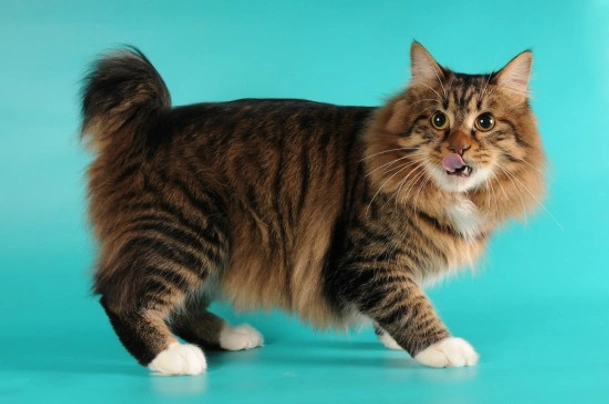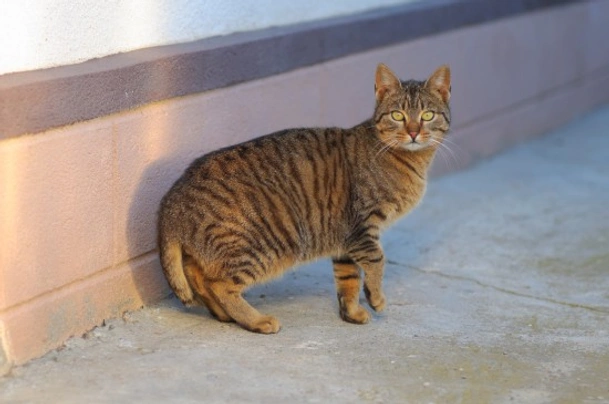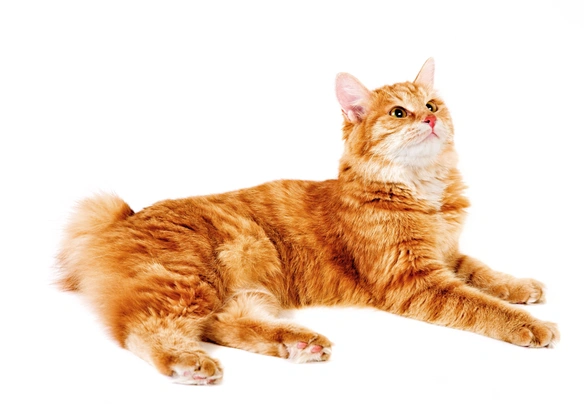American Bobtail
Introduction of the American Bobtail
The American Bobtail is a relatively new breed originating in the USA in the 1960s though not receiving much publicity until relatively recently. It is rarely seen in the UK as it is not recognised by the Governing Council of the Cat Fancy (GCCF) and therefore cannot be shown at GCCF shows. It can be either a shorthaired or semi-longhaired variety and is distinguishable by its shorter length tail which is between a third and a half the length of that of a more conventional breed. As the length of tail is not a programmable gene and cannot be bred specifically to order it is said that no two tails are ever the same and unlike other cats the American Bobtail will often wag its tail to show pleasure. The longhaired variety is described as having a shaggy-looking coat (rather than dense or fluffy) as befits the connection to wild bobcats from whom they are thought to descend whereas the shorthaired American Bobtails have rather plush coats This is a sturdy rather rugged looking cat and both varieties are medium to large in size with males weighing around 15lb and females a little smaller.
History of the American Bobtail
The early history of the American Bobtail is consistently recorded. In the late 1960s a young American couple John and Brenda Sanders of Iowa were on holiday near an Indian reservation in Arizona when they found a stray short-tailed brown tabby kitten which they adopted and took back home to Iowa with them. They named the kitten Yodie and although his parentage was unknown he was thought to be a bobcat/domestic cat hybrid because of his short stubby tail. In due course he was mated with a colour pointed non-pedigree shorthaired female cat (with normal tail length) called Mishi belonging to the couple. When the kittens arrived they too had Yodie's distinctive short tail and a friend of the Sanders Mindy Schultz saw the potential for a new breed of cat and by mating several of the female kittens to a pedigree longhaired male colourpoint the first American Bobtails were born. Later on Birmans Himalayans and a Himalayan/Siamese cross (all colourpointed varieties of cat) were added to the breeding programme and the first provisional Standard of Points for this new breed was written by Mindy Schultz (as the first recognised American Bobtail breeder) in the early 1970s. However the early days of the American Bobtail resulted in a great deal of inbreeding and the subsequent problems that it can bring and so in the 1980s a group of breeders devised a new breeding programme. They went away from the early lines which had mostly had a long coat and white mittens and a white face blaze and which were difficult to breed consistently true and the cat that is recognised today as an American Bobtail was recognised in the USA by The International Cat Association (TICA) in 1989 and by the Cat Fanciers' Association (CFA) in 2000.
Appearance of the American Bobtail
Since the original lines were phased out due to problems with inbreeding from a very small gene pool there is now a conscious effort to produce American Bobtails that resemble the wild bobcat in physical appearance with a friendlier more domestic temperament and they are very athletic-looking cats with a sturdy frame. The American Bobtail comes in many recognised colours and patterns and although out-crossing to other recognised breeds is no longer permitted they are mated with domestic non-pedigree shorthairs to increase the gene pool but not to bobcats or other feral cats. Colours include black brown chocolate cinnamon blue lilac fawn red and cream and patterns can include various tortie (in the females) shaded tipped and tabby patterns. Any colour eyes are acceptable usually relating to the coat colour and are almond in shape. The ears are of medium size with rounded tips and set in a position midway between the top and the side of the head adding to the overall picture of a medium wedge-shaped head. The tail should stop just below the level of the hocks when hanging down and their feet are large and round quite often with toe tufts of hair. This breed is slow to mature sometimes taking as long as three years to reach full maturity.
Temperament of the American Bobtail
American Bobtails make excellent family pets getting on well with children and other pets. They become devoted to their owners often attaching themselves to one particular family member singled out to be the favourite and although they love to play and will often retrieve objects thrown for them they are not demanding in the way that some of the Oriental breeds are and often greet their owners but with quite a gentle voice compared to many other breeds. This is a very intelligent breed with an alert expression as might be expected for cats with an ancestry that has had to fend for itself way back in the past.
Intelligence / Trainability of the American Bobtail
The American Bobtail is not known to have any breed-specific health problems and many live to around the age of 15 years. In common with other cats they need annual vaccination boosters against the common feline ailments of flu and enteritis as well as against Feline Leukaemia if they go outdoors - if they are allowed out in the garden be aware that they were once related to the Bobcat and may bring you back gifts of wildlife!
Children and other
The American Bobtail will eat most good quality proprietary brands of cat food but will also enjoy treats of cooked chicken ham and grated cheese. However cows' milk will probably give them a stomach upset and a bowl of water should always be available. The shorthaired variety have very short coats which need little grooming and can normally be kept free of loose hairs simply by stroking but the longhaired variety will need regular brushing and combing to keep the coat free of tangles and loose hair.
Health of the American Bobtail
Caring for the American Bobtail
Grooming of the American Bobtail
Exercise of the American Bobtail
Feeding of the American Bobtail
American Bobtail price



